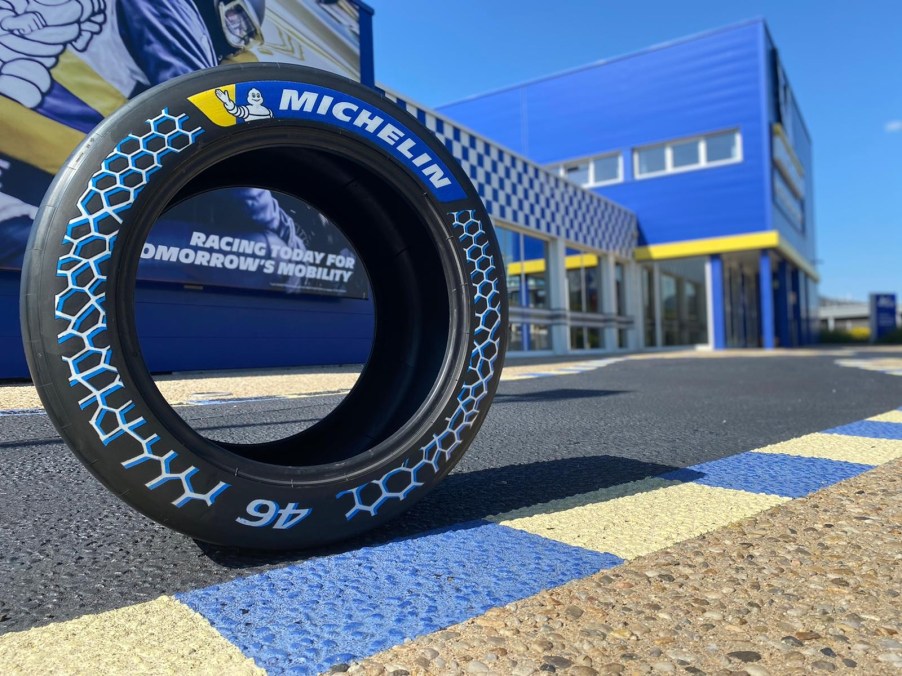
How Oranges and Beer Cans Make Michelin’s New Tire More Sustainable
Whether you buy high-performance or all-season tires, they’re essential tools that quite literally keep your car on the road. And the technology that goes into their design, testing, and manufacturing has changed significantly over the years. But mounting concerns over tires’ environmental impacts means more evolution is coming. And one of the first steps in that direction is the latest Michelin racing tire.
46% of the materials in the new Michelin racing tire are sustainable—including the rubber

Tires have shifted from bias-ply to radial design, but rubber remains a critical component. And it’s still a key ingredient in the new, as-yet-unnamed Michelin racing tire. However, this new tire revealed at the 2021 Movin’On Summit takes a different approach when it comes to sourcing its rubber, RideApart explains. And that same sentiment applies to the rest of the tire’s ingredients.
Michelin claims that its new racing tire is composed of 46% sustainable materials. For example, much of the synthetic rubber in the recipe is replaced with the natural stuff. And the soot-like carbon black used to reinforce the rubber comes from recycled tires at the end of their lifespans. This cuts down on crude oil use, RideApart explains.
But sustainability is built into this new Michelin tire in more places than just the rubber. Modern tire recipes sometimes call for over 200 different materials, The Drive notes, and Michelin tried to sustainably source as many as possible. That means using things like pine resin, sunflower oil, as well as lemon and orange rinds to tweak the tire’s physical properties. And the radials use metal from recycled cans, including beer cans, RideApart reports.
A racing tire with sustainable materials is only one part of Michelin’s environmental strategy

The racing tire made of 46% sustainable materials is a solid first step, but Michelin is going further. Earlier this year, the company announced a plan to make tires from recycled plastic trash. Michelin also has a carbon-neutral tire already on the market: the e.Primacy. However, as of this writing, it’s only available to European customers.
Furthermore, Michelin has partnered with Swedish recycling company Enviro to recycle the tires used in MotoE races, RideApart notes. The two companies are currently constructing a joint recycling facility to recover rubber, carbon black, and steel. It’s likely the racing tire announced at the Movin’On Summit will use some of those recovered materials.
Michelin is doing all of this to achieve its long-term sustainability goals. The company wants all of its tires to have at least 40% sustainable materials by 2030. And by 2050, Michelin wants to increase the sustainable material content to 100%.
Will this trickle down to ordinary drivers?
It’s worth noting that Michelin isn’t the only tire company pursuing sustainable materials and/or reducing its environmental impact. Yokohama, for example, introduced a tire with a citrus-oil-derived rubber compound in 2010. And Goodyear partnered with Sketchers to develop shoes that use soybean-oil-derived rubber compounds like those found in several Goodyear tires.
As for when this new Michelin tire recipe could hit real-world roads, the French company plans to test the tire on racing circuits first. It’s partnering with the GreenGT team to use the latter’s hydrogen-powered endurance race car as a testing mule. And theoretically, the lessons learned there will eventually become available in a street-legal tire.
So, sometime soon, ‘orange peel’ won’t just be a paint defect, but a tire component, too.
Follow more updates from MotorBiscuit on our Facebook page.


